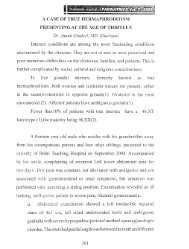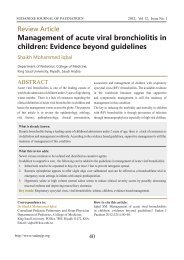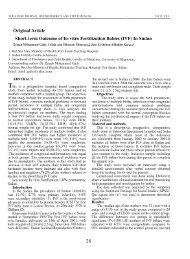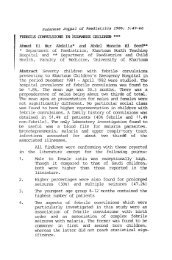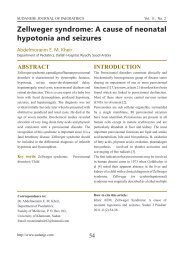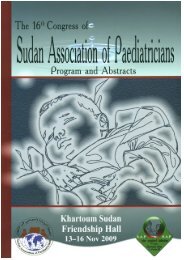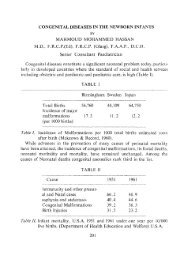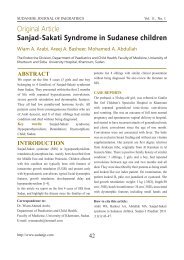Cerebral Malaria in Children: A Review of ... - Sudanjp.org
Cerebral Malaria in Children: A Review of ... - Sudanjp.org
Cerebral Malaria in Children: A Review of ... - Sudanjp.org
Create successful ePaper yourself
Turn your PDF publications into a flip-book with our unique Google optimized e-Paper software.
SUDANESE JOURNAL OF PAEDIATRICS AND CHILD HEALTH VallO: 2010Like most countries <strong>in</strong> sub-Saharan Africa, Sudancarries a heavy malaria disease burden. It ranks highas the one <strong>of</strong> the most endemic country <strong>of</strong> the world.It accounts for 50% <strong>of</strong> malaria cases <strong>in</strong> the EasternMediterranean Region. It is estimated that more than8 million cases and about 35,000 deaths occur peryear. The disease accounts for 20% <strong>of</strong> all hospitaldeaths and the malaria case fatality rate for paediatrichospitals ranges between «515- per cent».5The epidemiological pattern <strong>of</strong> severe malariavaries considerably from that <strong>of</strong> hyperdynamic regions<strong>in</strong> sub-Saharan Africa and there is considerablevariation between the <strong>in</strong>dividual complications <strong>of</strong>severe malaria.6Severe <strong>Malaria</strong>Severe malaria occurs when P. falciparum<strong>in</strong>fections are complicated by serious <strong>org</strong>an failuresor abnormalities. It is usually manifests <strong>in</strong> Africanchildren grow<strong>in</strong>g up <strong>in</strong> malarious endemic areas.7Many factors thought to contribute to P. falciparumvirulence these <strong>in</strong>clude:-a- The Redundancy and multiplicative Capacity<strong>of</strong> P. falciparumP. falciparum is able to <strong>in</strong>fect the entirepolymorphic human population; this is due to variantsurface antigens such as Plasmodium falciparumerythrocyte membrane prote<strong>in</strong>-I (PfEMP I) whichspecifically b<strong>in</strong>ds to adhesion molecule CD36 andthrombospond<strong>in</strong> which assists the parasite adherenceto various receptors and removal from the circulationavoid<strong>in</strong>g the snlenic clearance.8b- Parasitized RBCs Membrane Modification:These <strong>in</strong>cludefor mation <strong>of</strong> knob-like structurescomposed <strong>of</strong> prote<strong>in</strong>s (PfEMP-l), protrud<strong>in</strong>g fromtheir surfaces <strong>in</strong>creas<strong>in</strong>g cell wall rigidity and alter<strong>in</strong>gthe metabolites transport. 9c- Cyto-adherence and sequestration <strong>of</strong> parasitizederythrocytes. This is a specific <strong>in</strong>teraction betweenRBCs and the vascular endothelium lead<strong>in</strong>g tosequestration <strong>of</strong> parasitized RBCs <strong>in</strong> deep <strong>org</strong>anspredom<strong>in</strong>antly <strong>in</strong> the bra<strong>in</strong>, heart, lungs and submucosa<strong>of</strong> the small <strong>in</strong>test<strong>in</strong>e.10d- Rosett<strong>in</strong>g and Agglut<strong>in</strong>ation;e- RBC Deformability: In severe malaria bothparasitized (PRBCs) and non-parasitized RBCs(NPRBCs) become rigid due to oxidative damage tothe RBCs compris<strong>in</strong>g their flow through capillaries.This has strong predictive value for fatal outcome.I IThe polymorphism <strong>of</strong> genes cod<strong>in</strong>g four humanadhesion molecules; <strong>in</strong>tercellular adhesion molecule-l(ICAM-I), endothelial select<strong>in</strong> (E-selection), CD36are important variable <strong>in</strong> the susceptibility to severemalaria.12The manifestations <strong>of</strong> severe malaria <strong>in</strong>cludeamong others; cerebral malaria with abnormalbehaviour, impairment <strong>of</strong> consciousness, seizures,coma or other neurologic abnormalities and metabolicacidosis present<strong>in</strong>g as respiratory distress or severeanaemia. Compared with adults, children have ahigher <strong>in</strong>cidence <strong>of</strong> seizures.12The <strong>in</strong>cidence andpattern <strong>of</strong> neurological complications are differentand the patients <strong>of</strong>ten die with features <strong>of</strong> bra<strong>in</strong>death. African children rarely develop renal failure orpulmonary oedema.13<strong>Cerebral</strong> malaria (CM)There is a clear need for a strict def<strong>in</strong>ition <strong>of</strong>cerebral malaria <strong>in</strong> order to properly diagnose andassess the condition. The term «cerebral malaria»<strong>of</strong>ten been loosely used <strong>in</strong> the medical literature todescribe any disturbance <strong>of</strong> the CNS <strong>in</strong> a malaria<strong>in</strong>fection. CM collectively <strong>in</strong>volves the cl<strong>in</strong>icalmanifestations <strong>of</strong> P. falciparum malaria that <strong>in</strong>duceschanges <strong>in</strong> mental status and coma.13, CM hence,is an acute widespread disease <strong>of</strong> the bra<strong>in</strong> which isaccompanied by fever.In older children CM can be def<strong>in</strong>ed as <strong>in</strong> adults.15



